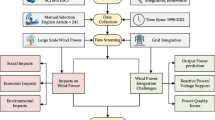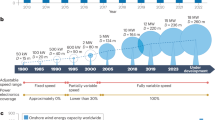Abstract
The use of wind to generate electrical energy is becoming more popular around the world as global efforts are made to deal with green house gas emissions from more traditional sources of energy. In Australia wind energy is one of the technologies being promoted by mandatory renewable energy targets set by the government [1]. Even though wind energy is more economical and eco-friendly it has one significant problem. The electricity production is inherently highly variable and difficult to predict. Over longer time scales it means that it is difficult to match electricity generation to the daily and seasonal patterns of demand. On shorter time scales the higher frequency “noise” in electricity output causes problems for network stability and managing the short term dispatch of generators to meet demand.
Access this chapter
Tax calculation will be finalised at checkout
Purchases are for personal use only
Preview
Unable to display preview. Download preview PDF.
Similar content being viewed by others
References
Kent A, Mercer D (2006) Australia’s mandatory renewable energy target (MRET): an assessment, Energy Policy 34(9):1046–1062
Kaiser R (2007) Optimized battery-management system to improve storage lifetime in renewable energy systems, Journal of Power Sources 168(1):58–65
Author information
Authors and Affiliations
Editor information
Editors and Affiliations
Rights and permissions
Copyright information
© 2008 Springer-Verlag Berlin Heidelberg
About this paper
Cite this paper
Ernst, A.T., Singh, G. (2008). Taming Wind Energy with Battery Storage. In: Kalcsics, J., Nickel, S. (eds) Operations Research Proceedings 2007. Operations Research Proceedings, vol 2007. Springer, Berlin, Heidelberg. https://doi.org/10.1007/978-3-540-77903-2_31
Download citation
DOI: https://doi.org/10.1007/978-3-540-77903-2_31
Publisher Name: Springer, Berlin, Heidelberg
Print ISBN: 978-3-540-77902-5
Online ISBN: 978-3-540-77903-2
eBook Packages: Business and EconomicsBusiness and Management (R0)




